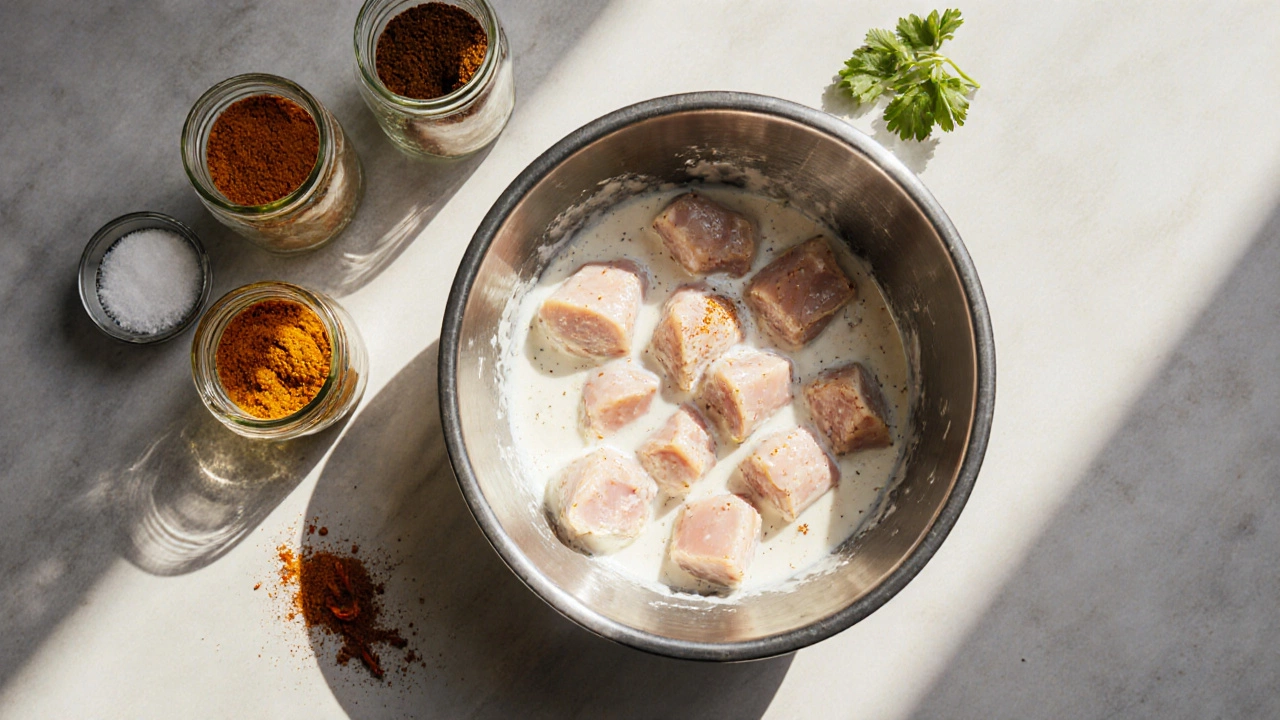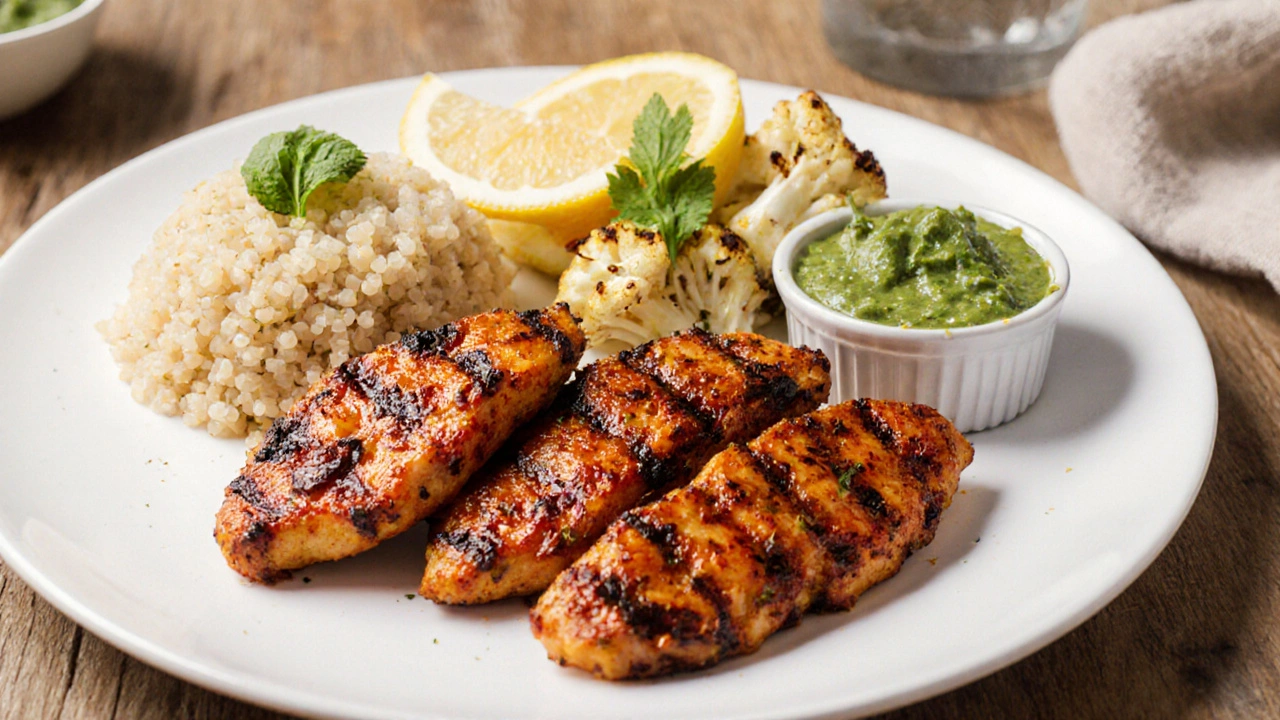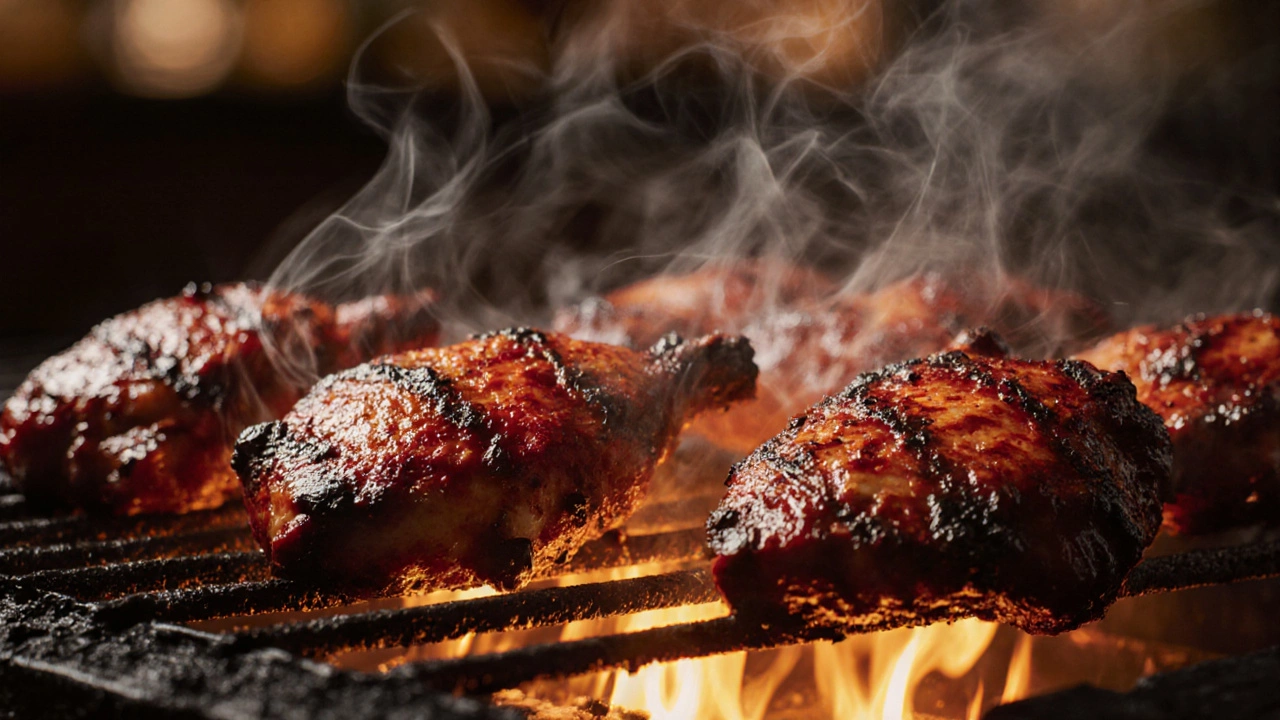Chicken Tandoori Health Calculator
Customize Your Chicken Tandoori
Adjust the ingredients and portion size to see how they affect the nutritional profile.
Nutritional Analysis
Calories:
Protein: g
Total Fat: g
Saturated Fat: g
Sodium: mg
Carbohydrates: g
When you hear chicken tandoori is a marinated grilled chicken dish from North Indian cuisine, known for its bright red hue and smoky flavor, you probably picture a restaurant plate that sizzles on a hot charcoal grill. But does that tasty plate pass the health test?
Key Takeaways
- Traditional chicken tandoori provides about 200‑250kcal per 100g, is high in protein, but can be high in sodium and saturated fat.
- Grilling is a low‑fat cooking method, yet the marinade’s yogurt and oil add calories.
- Swap regular yogurt for Greek yogurt, trim excess oil, and use low‑sodium spices to cut up to 30% of calories and sodium.
- It fits well in high‑protein diets like keto or paleo, but watch the spice‑added salt if you have hypertension.
- Vegetarian alternatives (paneer or tofu tandoori) give similar flavors with different nutrient profiles.
What Makes Chicken Tandoori Tick? (Nutrient Breakdown)
Understanding the health picture starts with the core ingredients:
- Chicken breast - lean protein, ~31g protein per 100g, low in carbs.
- tandoori masala - a blend of cumin, coriander, turmeric, chili, and fenugreek. The spices themselves add antioxidants but also bring sodium if salt is mixed in.
- yogurt - the traditional marinade base. It supplies calcium and a mild tang, but also contributes calories (about 60kcal per 100g of plain full‑fat yogurt).
- oil - often a tablespoon of mustard or vegetable oil for sheen, adding ~120kcal per tbsp.
- grilling - the cooking method that lets excess fat drip away, keeping the final fat content lower than pan‑frying.
Putting those numbers together, a standard 100‑gram serving of chicken tandoori averages:
- calories: 210‑250kcal
- protein: 28‑32g
- fat: 8‑12g (mostly unsaturated)
- sodium: 400‑600mg (depends on added salt)
Assessing the Health Score: Pros and Cons
Now that we have the numbers, let’s weigh the pros against the cons.
Pros
- High‑quality protein: Supports muscle repair, satiety, and metabolism.
- Low carbohydrate: Ideal for keto, low‑carb, or diabetic meal plans.
- Spice antioxidants: Turmeric’s curcumin, chili’s capsaicin, and coriander’s flavonoids have anti‑inflammatory properties.
- Grilling reduces fat: The open flame lets excess oil drip off, unlike deep‑frying.
Cons
- Potential sodium overload: Store‑bought masala blends can contain 1g+ of salt per tablespoon.
- Added saturated fat: Full‑fat yogurt and oil increase total calories.
- Advanced cooking risks: High‑heat grilling can form heterocyclic amines (HCAs) and polycyclic aromatic hydrocarbons (PAHs), which are linked to cancer when consumed in large amounts.
- Portion illusion: Restaurant servings often exceed 200g, pushing calories past 500kcal per plate.

How to Make a Healthier Chicken Tandoori at Home
Good news: you control the ingredients, so you can keep the flavor while cutting the downsides. Follow this chicken tandoori health cheat sheet.
- Choose skinless, boneless chicken breast or thigh (thigh adds a bit more juiciness but also more fat).
- Swap regular yogurt for Greek yogurt (0% fat) - you halve the calories and boost protein.
- Make your own tandoori masala with spices and skip the added salt. Use 1tsp of sea salt max.
- Limit oil to a light drizzle or use a non‑stick spray. You’ll still get a glossy crust without the extra 120kcal per tbsp.
- Marinate at least 4hours (overnight is best) - longer marination improves flavor, so you don’t need to over‑season.
- Grill on a pre‑heated grill or a broiler set to high, turning once. Aim for an internal temperature of 165°F (74°C).
Result? A 100‑gram portion that clocks in around 150kcal, 30g protein, 4g fat, and under 300mg sodium.
Comparison: Traditional vs. Healthier Chicken Tandoori
| Attribute | Traditional | Health‑Focused |
|---|---|---|
| Calories | 210‑250kcal | ~150kcal |
| Protein | 28‑32g | 30‑34g |
| Fat | 8‑12g | 3‑5g |
| Saturated Fat | 2‑3g | 0‑1g |
| Sodium | 400‑600mg | 200‑300mg |
| Carbs | 2‑4g | 1‑2g |
Who Can Benefit Most From Chicken Tandoori?
Because it’s protein‑rich and low‑carb, certain diets hug it tightly:
- Keto / Low‑Carb: Keeps carbs under 5g while delivering 30g protein.
- Paleo: Use grass‑fed chicken and avoid dairy by swapping yogurt with coconut milk (adds healthy fats).
- High‑Protein Fitness: Great post‑workout meal; pair with a side of roasted veggies for micronutrients.
- Heart‑Healthy (Mediterranean): Opt for olive‑oil drizzle, lower salt, and serve with a lemon‑herb salad.
If you have hypertension or are watching sodium, stick to the low‑salt homemade version or limit portions.

Potential Pitfalls & How to Avoid Them
- Over‑salting the masala: Measure salt, or use potassium‑based salt substitutes.
- Using too much oil: Weigh oil (1tsp ≈ 5ml) instead of eyeballing.
- Cooking at excessive heat: Keep grill temperature around 400°F; scorching creates HCAs.
- Portion creep: A single adult serving is 150‑200g; pre‑measure to avoid hidden calories.
Healthy Twists & Side Pairings
Boost the meal’s nutritional balance with these simple add‑ons:
- Quinoa or brown rice: Adds fiber and B‑vitamins.
- Roasted cauliflower: Low‑calorie, high‑vitamin C, and complements the smoky flavor.
- Mint‑coriander chutney: Fresh herbs, minimal sugar, good for digestion.
- Greek yogurt dip (instead of creamy ranch) - extra protein, lower fat.
Frequently Asked Questions
Is chicken tandoori low in calories?
A standard restaurant portion (~200g) contains roughly 400‑500kcal. Homemade, portion‑controlled recipes can drop to about 150kcal per 100g, making it a moderate‑calorie option.
How much protein does chicken tandoori provide?
Skinless chicken breast in a tandoori style delivers 28‑34g of high‑quality protein per 100g, supporting muscle maintenance and satiety.
Can I make chicken tandoori suitable for a low‑sodium diet?
Yes. Use a homemade masala without added salt, limit the amount of regular salt in the marinade, and choose low‑sodium yogurt. The result can stay under 300mg sodium per 100g.
Is grilled chicken tandoori safer than fried versions?
Grilling lets fat drip away, keeping overall fat lower than deep‑frying. However, avoid charred edges to limit HCAs; cook at moderate high heat and turn once.
What are good vegetarian alternatives?
Paneer tandoori or tofu tandoori use the same spice mix and yogurt‑based marination, offering similar flavor with different protein and fat profiles.
Does chicken tandoori fit a diabetic meal plan?
Yes, because it’s low in carbs. Pair with fiber‑rich sides like lentil dal or quinoa to balance blood sugar.
Bottom Line
Chicken tandoori can be a healthy, protein‑packed dish when you control the marinade, limit sodium, and keep the grilling temperature in check. The traditional version isn’t a health nightmare, but the homemade, low‑fat tweak makes it a smart addition to most diet plans.
